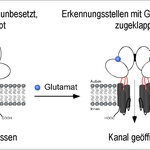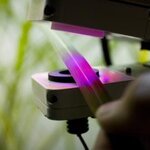Science category landing
Life Sciences

Our brain creates our imagination by switching electric signals within a huge network of approximately 100 billion nerve cells, the individual nerve cells not having direct electric contact to each other, but being separated by a very small gap.
Any signals which are to be transmitted from one cell to the other need to bridge this gap. This is done by the so-called synapses, special points of contact, where signals are transmitted by way of a chemical messenger, the neurotransmitter, , which is discharged by the electrically excited nerve cell. The neurotransmitter then traverses the gap and…

An immune system messenger molecule that normally helps quiet inflammation could be an effective tool against multiple sclerosis (MS). Neurology researchers led by Abdolmohamad Rostami, M.D., Ph.D., professor and chair of the Department of Neurology at Jefferson Medical College of Thomas Jefferson University and the Jefferson Hospital for Neuroscience in Philadelphia, have found that the protein interkeukin-27 (IL-27) helped block the onset or reverse symptoms in animals with an MS-like disease.
The results suggest that IL-27 may someday be part of a therapy to temper over-active immune…

The HIV-1 virus is one of the most difficult targets for therapy because it hijacks the cells of our immune system and particularly because the virus mutates rapidly, making it drug resistant. Up to 20% of HIV-infected patients host virus that is drug resistant.
The current "Highly active antiretroviral treatment" (HAART therapy) against HIV uses a combination of several different drugs, which increases the probability of simultaneous development of resistance against different drugs. A team of Slovenian undergraduate students from the University of Ljubljana together with their mentors from…

Photosynthesis converts light energy into chemical energy in plants, algae, phytoplankton and some species of bacteria and archaea. Photosynthesis in plants involves an elaborate array of chemical reactions requiring dozens of protein enzymes and other chemical components. Most photosynthesis occurs in a plant’s leaves.
Now University of Illinois researchers have built a plant that produces more leaves and fruit without needing extra fertilizer using a computer model that mimics the process of evolution. Theirs is the first model to simulate every step of the photosynthetic process.
The…

Overweight children and adults have low levels in their blood of a protein known as SHGB, which transports sex steroids and regulates their entry into tissues. Low levels of SHGB are a marker of the metabolic syndrome, a combination of medical disorders that increase an individual’s risk of developing type 2 diabetes and heart disease.
An explanation as to why low levels of SHGB are such a good marker of the metabolic syndrome are now provided by Geoffrey Hammond and colleagues at the University of British Columbia, Vancouver.
In the study, exposure to glucose and fructose (monomeric sugar…

Is sexual orientation something people are born with - like the color of their skin and eyes - or a matter of choice?
Canadian scientists say they have uncovered new evidence which shows genetics has a role to play in determining whether an individual is homosexual or heterosexual.
The research was conducted by Dr. Sandra Witelson, a neuroscientist in the Michael G. DeGroote School of Medicine at McMaster University, and colleagues at Sunnybrook Health Sciences Centre in Toronto who studied the brains of healthy, right-handed, 18- to 35-year-old homosexual and heterosexual men using…

Scientists from P&G Beauty announced that they successfully sequenced the complete genome for Malassezia globosa (M. globosa), a naturally occurring fungus responsible for the onset of dandruff and other skin conditions in humans.
Dandruff and seborrheic dermatitis affect more than 50 percent of the human population. Despite the role of Malassezia in these and other common skin diseases, including eczema, atopic dermatitis and psoriasis, little was known about the fungus at the molecular level until this study. In addition, understanding of Malassezia’s genetic make-up may help…

Inheriting two genetic mutations that can individually cause epilepsy might actually be “seizure-protective,” said Baylor College of Medicine researchers the journal Nature Neuroscience.
“In the genetics of the brain, two wrongs can make a right,” said Dr. Jeffrey L. Noebels, professor of neurology, neuroscience and molecular and human genetics at BCM. “We believe these findings have great significance to clinicians as we move toward relying upon genes to predict neurological disease.”
In addition, the finding might point the way to new ways of treating epilepsy using gene-directed therapy…

Scientists at the University of Liverpool have discovered that mice rely on a special set of proteins to recognize each other.
Previous studies assumed that another set of genes that influence smell in vertebrates might be used by animals that identify each other through scent. The team found, however, that mice use a highly specialized set of proteins in their urine to recognize different individuals, suggesting that this may also be true of other animals.
Professor Jane Hurst, Director of the Mammalian Behaviour and Evolution research group, explains: “For many years scientists assumed that…

Case Western Reserve University researchers have bred a line of 'super mice' (PEPCK-Cmus mice) that have the capability of running five to six kilometers at a speed of 20 meters per minute on a treadmill for up to six hours before stopping.
“They are metabolically similar to Lance Armstrong biking up the Pyrenees; they utilize mainly fatty acids for energy and produce very little lactic acid,” said Richard W. Hanson.
These genetically engineered mice also eat 60 percent more than controls, but remain fitter, trimmer and live and breed longer than wild mice in a control group. Some female…